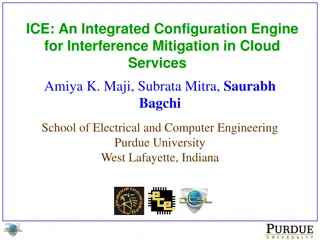Sub Working Group Conclusions on Various Spectrum Interference Analyses
The draft report highlights conclusions from different sub working groups regarding spectrum interference analyses in various sectors like aeronautical telemetry, small unmanned aerial systems, air combat training systems, and precision guided munitions. It discusses feasibility challenges, separation distance requirements, and potential future analysis areas. The report also identifies sharing limitations and proposes techniques for interference mitigation.
Download Presentation

Please find below an Image/Link to download the presentation.
The content on the website is provided AS IS for your information and personal use only. It may not be sold, licensed, or shared on other websites without obtaining consent from the author.If you encounter any issues during the download, it is possible that the publisher has removed the file from their server.
You are allowed to download the files provided on this website for personal or commercial use, subject to the condition that they are used lawfully. All files are the property of their respective owners.
The content on the website is provided AS IS for your information and personal use only. It may not be sold, licensed, or shared on other websites without obtaining consent from the author.
E N D
Presentation Transcript
Working Group 5 Draft Report On Sub Working Group Conclusions 1
WG 5 Approach Performed interference analysis in both direction Government systems to LTE LTE to Government Systems Determined separation distance for federal operations and LTE systems 2
Sub Working Group Aeronautical Mobile Telemetry (AMT) Conclusions: Sharing is not feasible between AMT and LTE Range of separation distance requirements would severely limit LTE deployment in top 100 commercial markets Changes to WG5 agreed assumptions may change the range of required protection distances and in turn may render different conclusions Identified Possible Future Analysis 3
Sub Working Group Small Unmanned Aerial Systems Conclusions: Sharing does not appear feasible, based on the analysis result identifying large separation distance requirements Industry view at this time is conclusion cannot be assessed due to insufficient Publicly Releasable Data Analysis Focused on Protection Distances UE to SUAS: beyond 300 KMs SUAS to Base Stations: at least 285 KMs Identified Possible Future Analysis 4
Sub Working Group Air Combat Training Systems Conclusions: Sharing would likely impose unacceptable operational or economic constraints on ACTS operators or wireless operators. UE to ACTS: 325-375 KM distances ACTS to Base Stations: 285-415 KM distances Identified Possible Future Analysis, including some sharing techniques 5
Sub Working Group Precision Guided Munitions/Other Airborne Systems Conclusions: 8 Systems Identified PGM, TactiLink, VORTEX, ROVER, DRAGOON, LITENING/Sniper: Relocation to comparable spectrum JTRS AMF: Protection Zones at selected priority areas for entire band/elsewhere 1780-1850 MHz TTNT (exc Navy): Protect DOD priority sites for entire band 1755-1850 MHz 6
Future Analysis Options Identified Time-based & Geographic-based Sharing Off-tuning of LTE Base Stations Notching specific LTE channels at selected locations Alternate interference threshold based on desired signal level desired Possible effects of clutter/terrain UE Antenna Height 7























